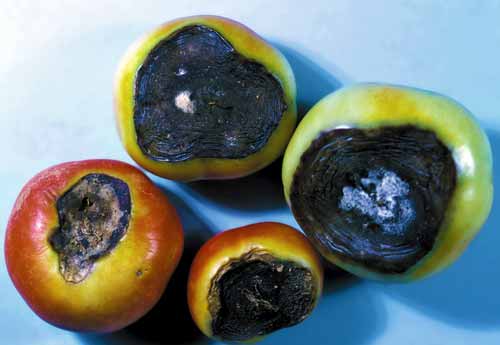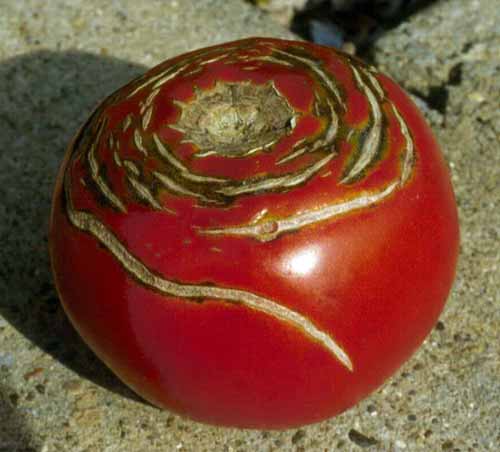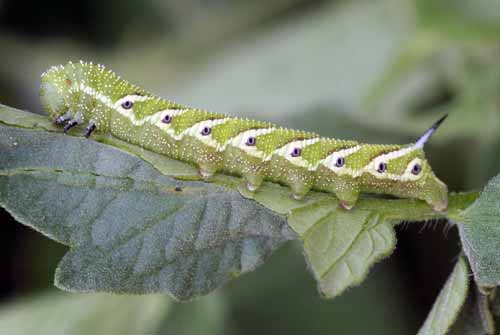When bad things happen to good tomatoes
Tomato fruit damage before harvest may be prevented.
As the season of the tomato reaches its pinnacle, anxious gardeners around Michigan are eyeing their tomatoes and contemplating everything from bacon, lettuce and tomato sandwiches to pasta primavera. But some of those hopes could be dashed when they find that their tomatoes have damage to them. Here are some of the possibilities of tomato fruit damage and ways to prevent damage, either this year or next. Michigan State University Extension hotlines are supplying this information to gardeners every day through the 888-678-3464 toll-free number.
Physiological damage
Physiological damage is damage that is not caused by insects or disease. The most common problem is called blossom end rot. The top half of the tomato appears normal, but the bottom half is flattened, leathery and discolored. It is caused by a lack of water or irregular watering for the plants. Plants in gardens may have fewer problems this year (2013) because of adequate rain for most of the growing season. However, tomatoes in containers could still have a problem because of lack of root room. Tomato-growing articles may indicate that it is caused by a lack of calcium, but is actually a lack of water to carry the calcium from the soil, through the roots to the end of the fruit.

Tomato blossom end rot. Photo credit: David B. Langston, University of Georgia, Bugwood.org
Growth cracks happen to the opposite end of the tomato. These are cracks that develop on the stem end. They can be either radial or concentric. Radial cracks radiate away from the stem and resemble an asterisk. Concentric rings make a circle around the stem. Both are caused by varying amounts of moisture in the soil from very dry to very wet. The skin expands rapidly at the stem end and cracks happen. Essentially, the tomato got too big too fast and split its pants.

Tomato concentric rings. Photo credit: Paul Bachi, University of Kentucky Research and Education Center, Bugwood.org
Prevention: Check soil every day and water widely and deeply around the plants. Roots could go as deep as 12 inches and at least 1 foot to the sides. Mulch the soil with straw if the soil is drying too rapidly.
Critter and slug damage
Fruit can have missing bites or chew marks. These can be caused by both birds and mammals. Bird damage may look like someone stabbed the fruit with a pencil; it is a conical puncture. Pheasants are known to poke into fruit to get moisture. Deer can bite on tomatoes and damage is usually to the top of the fruit. Raccoons can try to rip fruit away or just bite in place. Damage to the lower portions of the tomato could be chipmunks or, in rare circumstances, turtles. Turtle damage can make it appear that the top or side of the tomato has been shallowly gnawed.
Tomato plants that are left to sprawl on the ground have fruit that touches the soil or mulch. Slugs can chew the skin and some tissue on the soil side.
Prevention: Use tomato cages or staking to keep plants off the ground for the short animals and slugs. It might be necessary to fence in tomatoes in to keep deer and raccoons away from the plants.
Tomato hornworm damage
The biggest problem is usually tomato hornworms, which are also called the tobacco hornworm. This large, green caterpillar has a curved spike on the rear end. It eats leaves and holes in fruit, starting at the top of the plant.

Tomato hornworm. Photo credit: Whitney Cranshaw, Colorado State University, Bugwood.org
Prevention: Check for caterpillars and destroy them. It is possible to use a product containing Bacillus thuringiensis var. kurstaki when the larvae are small. Or, till up the garden right after harvest to destroy the pupating larvae in the soil. They are next year’s tomato eaters.
Disease
The only disease this late in the season is anthracnose. It damages fruit but not leaves. Damage occurs to the skin of the tomato and small, round, sunken areas develop. The fruit begins to rot at those areas. This can happen because of blowing sand in a garden essentially sandblasting the skin or a hailstorm that bruises the fruit.
Prevention: Prevent blowing sand in the garden by using straw mulch. There is not much one can do about a hail storm.



 Print
Print Email
Email